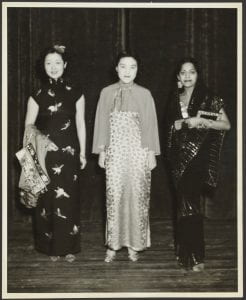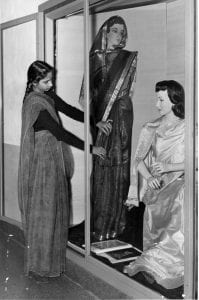FOR IMMEDIATE RELEASE
October 11, 2021
Contact: cornellfashion@cornell.edu
Curators: Emily Hayflick and Lynda May Xepoleas
Advisor: Dr. Denise N. Green
Location and Dates: Human Ecology Building, Level T Display Cases (October 15, 2021 – January 31, 2022)
Ithaca, N.Y. – In an upcoming fashion exhibition entitled, Engaging Communities, Empowering Students: Fostering Cross-Cultural Connections through Dress, 1936-1958, graduate student curators Emily Hayflick and Lynda May Xepoleas explore the different ways international students helped to foster cross-cultural understandings of dress on Cornell’s campus in the mid-twentieth century. The exhibition will open October 15th on Level T of the Human Ecology Building and on Cornell Library’s digital exhibitions platform. An opening reception will be held Thursday, October 28th at 5:00pm.
Leading up to the onset of World War II, home economists at U.S. institutions and colleges began to rethink their course offerings in order to cultivate “international friendships” between their students and home economists in universities abroad (Marlatt, 1933, p. 418). The urgency of this endeavor was summarized by Helen Canoyer, who served as the Dean of the College of Home Economics at Cornell University from 1953-1968. She stated, “The time has come when we in institutions of higher learning no longer may choose whether or not we should participate in international education” (Arny, 1964, p. 253). While discussions in the academic press were centered around how American students could tailor the knowledge they learned in the classroom to address the needs and lifestyle of those women living in different countries, a number of international students at Cornell directly influenced the representation of their cultural forms and practices through lectures, demonstrations, exhibitions, publications, and their own self-fashioning practices. Engaging Communities, Empowering Students focuses on the different stories and styles of students who attended Cornell in the mid-twentieth century and utilized dress to help to foster cross-cultural understandings between Cornell’s community and their home countries.

Sari collected by Blackmore in 1936 and worn by a student within the College of Home Economics who Lalitha Kumarappa helped dress for the 1938 fashion showcase. (CFTC #249). Photo courtesy of Lynda May Xepoleas.
Faculty and students in Cornell’s College of Home Economics employed a range of strategies to promote awareness and acceptance of diverse approaches to dress, from dissemination of international dress throughout the hallways and classrooms of Martha Van Rensselaer Hall (MVR) to the development of fashion showcases and exhibitions for Farm and Home Week.[1] Initially, international dress was represented within various showcases and exhibits during Farm and Home Week. This was largely due to the work of Professor Beulah Blackmore, Cornell’s first faculty member to teach clothing and textiles courses. In 1936, she cashed in her life insurance policy to travel the world with her colleague, Marion Pfund. She used $500 from the College of Home Economics to collect dress-and textile-related artifacts to illustrate her lectures on design and fashion history. After returning to Cornell’s campus, Blackmore circulate her collection through the fashion showcase “Costumes of Many Lands.” From 1937 to 1939, Blackmore worked with other Cornell faculty and students as well as missionaries on furlough to share the college’s collection among Cornell’s community during Farm and Home Week. According to the 1938 Homemaker’s Program,[2] the showcase was supposed to promote world peace by providing the audience with a greater understanding of the traditions and customs of other peoples. However, in her attempt to recreate the ethnic identities of those cultures she experienced abroad, Blackmore at times perpetuated the very divisions she sought to disrupt. For example, she had the faces of white-appearing students painted in black or brownface.

Olivia Wu, Mrs. Tsch Liang Kwan, and Lalitha Kumarappa shown wearing their own garments for the 1938 installment of “Costume of Many Lands.” (RMC #23-2-749, Box 114, Folder 25). Photo courtesy of Cornell Rare and Manuscript Collection.
Blackmore’s display practices are considered problematic by today’s standards, yet her collaboration with several international students enrolled in the College of Home Economics were quite progressive: she gave students a platform and voice to influence the representation of their dress practices, both within the fashion showcase and what would become known as the Cornell Fashion + Textile Collection (CF+TC). According to one press release, for example, Blackmore relied on the knowledge and expertise of Lalitha Kumarappa ‘39, a transfer student from Mumbai, India to help her dress several students in saris for the 1938 showcase. Other international students who participated in the event such as Olivia Wu ‘39 and Julia Sze ‘38 wore their own clothing that, at times, refuted Blackmore’s portrayal of international dress as unchanging and static, such as the modern qipao Wu donated to the Cornell Fashion + Textile Collection in 1939 that brought Western design and construction into conversation with traditional Chinese designs and materials.

Chinese qipao donated to the CF+TC by Olivia Wu ’39, a graduate student in the College of Home Economics (CFTC #196). Photo courtesy of Lynda May Xepoleas.

From left to right, Miss Muna Khoury of Lebanon, Mrs. Leonarda Jurado of the Philippines, Miss Iris Brunet of Puerto Rico, Miss Zahida Quraishi of Pakistan, and Miss Mercedes Melchor of the Philippines are shown in conversation with one another after participating in “Family Life in Other Lands.” (AC-FH-92). Photo courtesy of Human Ecology Historical Photographs.
In the 1950s, international students began to represent their own fashions during Farm and Home Week in lectures, demonstrations, and exhibitions. This was largely brought on by the students themselves. According to several reports published by the Student Review Committee, the students suggested that fashion showcases and pageants should be supplemented with “a more personal touch” whereby the audience could better engage with the costumes in exhibitions or between-act displays. In 1952, several graduate students in the College of Home Economics from Pakistan, China, and Iran contributed to a series of lectures entitled, “Family Life in Other Lands,” where they discussed the major issues and challenges currently impacting their home countries. In 1958, additional discussion sections were added to this event that concerned family life in the Philippines, Thailand, India, and Iraq. In addition to speaking about family life, these women collaborated with one another to represent and display their fashion in an exhibition on the second floor of MVR, which allowed them to directly influence the representation of their dress practices through extant objects. Lastly, during their presentations, the students chose to represent themselves through their self-fashioning practices, through which they negotiated their identities as international students on Cornell’s campus. The shoes photographed below were donated by Professor Margaret Hutchins in 1954 likely on behalf of Zahida Quraishi ’53, a graduate student in the College of Home Economics who spoke at Farm and Home Week in 1952 and 1953.

Shoes donated by Professor Margaret Hutchins that likely belonged to Zahida Quraishi ’53. (CFTC #360). Photo courtesy of Lynda May Xepoleas.
Each of the exhibition cases in Engaging Communities, Empowering Students are organized according to the different spaces or contexts in which garments on display were used, worn, and shown on Cornell’s campus. The first case, “Collecting Dress on and off Campus,” features items Professor Blackmore collected abroad as well as other artifacts donated to the collection by missionaries and international students. The exhibit case, “Disseminating Dress within the Classroom,” explores how artifacts were incorporated in fashion curricula and exhibitions on Cornell’s campus throughout the twentieth century. The third case, “Animating Dress Across Campus,” examines the different spaces and contexts where international students wore garments from the collection on campus. This case, in particular, makes use of photographs, newspaper articles, and ephemera to illustrate Blackmore’s collaboration with several international students including Lalitha Kumarappa ‘39, Lee Ong Jung ‘39, Julia Sze ‘38, and Olivia Wu ’39 who helped develop the 1937 and 1938 installment of “Costumes of Many Lands.” Lastly, the vitrine, “Self-fashioning on Campus and Beyond” shows how international students fashioned their bodies while studying at Cornell. While some students adopted styles worn by their American peers, others combined these styles with their existing wardrobes or exclusively wore the clothing they brought with them from their home countries, such as Anjani Mehta ’48 who regularly paired a sari with long sleeves and boots rather than with a choli and sandals.

Anjani Mehta ’48, who regularly wore saris on campus, is shown arranging an exhibition of Indian saris in Martha Van Rensselaer Hall, 1948. (DD-TC-99). Photo courtesy of Human Ecology Historical Photographs.
This exhibition features facsimiles of documents and photographs from Cornell University Library’s Division of Rare and Manuscript Collection (@rarecornell) alongside artifacts from the Cornell Fashion + Textile Collection (@cornellfashioncollection), and will be displayed on Level T of the Human Ecology Building from October 15, 2021 until January 31, 2022.
Title: Engaging Communities, Empowering Students: Fostering Cross-Cultural Connections through Dress, 1936-1958
Dates: October 15, 2021 – January 31, 2022
Location: Level T, College of Human Ecology Building (37 Forest Home Drive), Cornell University, Ithaca, NY 14853 and through Cornell Library’s Digital Exhibition Platform.
Land Acknowledgement: Cornell University is located on the traditional homelands of the Gayogo̱hó꞉nǫ’ (the Cayuga Nation). The Gayogo̱hó꞉nǫ’ are members of the Haudenosaunee Confederacy, an alliance of six sovereign Nations with a historic and contemporary presence on this land. The Confederacy precedes the establishment of Cornell University, New York State, and the United States of America. The Cornell Fashion + Textile Collection and the curator of this exhibition acknowledge the painful history of Gayogo̱hó꞉nǫ’ dispossession, and honor the ongoing connection of Gayogo̱hó꞉nǫ’ people, past and present, to these lands and waters. Furthermore, we acknowledge that Cornell University obtained 977,909 acres of expropriated Indigenous land through the Morrill Act of 1862. Please refer to the American Indian and Indigenous Studies Program’s Indigenous Dispossession Project Blog to learn more.
Funding: This exhibition is funded in part by the Cornell Council for the Arts, Cornell Fashion + Textile Collection, and the Department of Fiber Science and Apparel Design.
Curators: Emily Hayflick ’25 (PhD Student in Anthropology) eh664@cornell.edu and Lynda May Xepoleas ’22 (PhD Candidate in Apparel Design) lmx2@cornell.edu
Faculty Advisor: Denise Nicole Green, Director and Associate Professor, dng22@cornell.edu
Contributing Institutions: Cornell Fashion + Textile Collection and the Cornell Rare & Manuscript Collections, Cornell University Library.
Social media: Instagram: @cornellfashioncollection Facebook: @cornellfashion Hashtag: #curatingfashion@cornell
[1] Farm and Home Week was an event that ran every year at Cornell from 1907 to 1960 and provided the public with access to the university’s resources. Initially this event was called Farmer’s Week. In 1928 it became known as Farm and Home Week.
[2] The Homemaker’s Program initially consisted of a series of lectures given by faculty in the field of Home Economics.This eventually expanded to include daily lectures, demonstrations and exhibitions.

